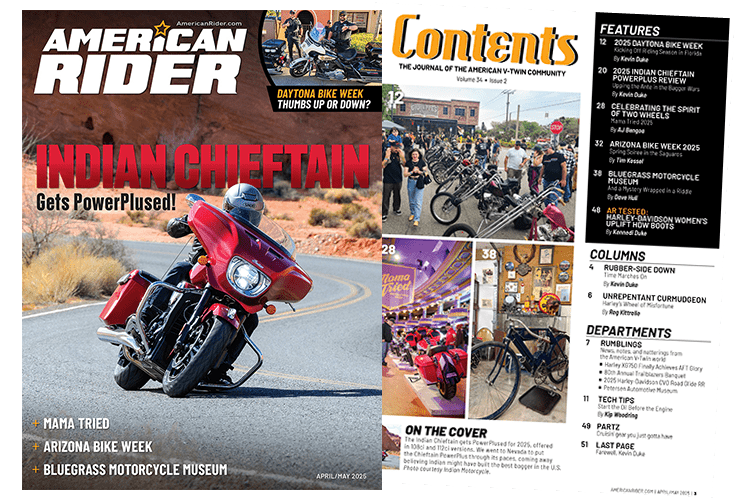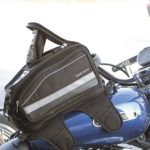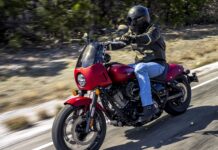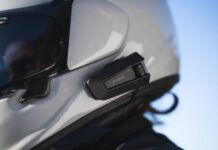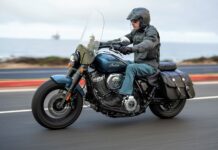Let me up front about this: Tank bags are rather personal pieces of luggage and every rider has different ideas as to what to pack in them. Even the best ones aren’t suitable for everyone, but the Laguna GPS Tank Bag is one of more interesting pieces of luggage that I’ve had the opportunity to test.
The design is based on the fact that more and more riders are carrying electronic gizmos with them while traveling, especially GPS units, cell phones and MP3 players. Firstgear designed a bag that would allow these units to be operable while riding, which means visible and plugged in. A GPS unit can be zippered into a 5″ x 4 1/2″ case with a clear acetate window. When not in use the case folds into a water-resistant compartment in the top of the bag and is zippered closed. When the GPS unit is being used the compartment is unzipped and the attached hinged case swings out. The case is secured at a 45-degree position by Velcro, and the LCD screen now can easily be viewed. My DeLorme PN-20 will only fit at a diagonal and my early Garmin not at all, so the smaller the GPS unit the better this feature works. (Note: I do not recommend viewing a GPS screen while a motorcycle is in motion.) The 4″ x 4 1/2″ cell phone/MP3 player compartment is located in front of the GPS (i.e., closer to you). It has a clear acetate window in the lid, but the zippered compartment is accessible only from the inside of the tank bag. If a bandana or something is packed behind an iPod, some of the controls can be operated through the acetate plastic, but plan on using Bluetooth technology for best results.
Instruments are powered by any one of several styles of auxiliary power cords running from the motorcycle battery. Small rubber grommets with a “+ ” – shaped slit allow ingress for electrical cords while maintaining a fairly high degree of water resistance. These “+”-shaped slits just barely allow a SAE plug to be pushed through them. The inside of the bag has four sets of Velcro tabs to allow routing of wires along the top left-hand edge without entangling the other contents stashed therein.
The bag zippers to a base that can be secured to any gas tank, whether it’s made of steel, aluminum or plastic. Obviously patterned after a bearskin rug, the four legs have Velcro-closed “paws” containing powerful magnets. The magnets are easily removed and four suction cups (included) attached. The base also has an excellent four-point nylon-strap tie-down system with quick-release buckles. The combination of the magnets and four-point straps provided me with a rock-solid bag that didn’t shift position at speed or in nasty crosswinds. Access to the gas cap is certainly easy enough by releasing the front two buckles, grasping the front two “paws” and lifting the bag towards my saddle. The base also has a zippered map pocket with an acetate window. It’s a good design.
Between the base and the bag are hidden two adjustable padded shoulder straps and a waist belt with a quick-release buckle that transforms the tank bag into a backpack. This feature is well thought out and better than any I’ve ever owned or tested. It also comes with a nylon shoulder strap—adjustable and with a plastic shoulder pad—that attaches to two D-rings by snap swivels. It even has an excellent, well-padded hand strap.
An attached rain cover is hidden in a zippered compartment at the front of the bag. The cover is a heavy PVC-coated nylon with a draw cord (not cheap elastic) and another acetate window. It’s a bit awkward to get the cover out when the tank bag is mounted on the bike, but practice will solve this issue.
The two sides of the bag have stiffeners to keep it rigid, but I noticed that the inside liner has a zipper on each side, and these can be removed. This could be a good place to keep crucial documents. There’s a cargo pocket on each side that measures 12 1/2″ long and 6″ tapering to 4″, but they are only an inch deep. The small pocket on the end has a flap with Velcro closure. The outside pockets are limited in capacity with the small one barely able to accommodate my business card case. Items thicker than one inch can be squeezed into the cargo pockets, and a decent pair of all-season gloves just fits.
Regardless of what the advertising copy states, the outside of the main bag actually measures14 1/2″ long and the width tapers from 11″ to 9″. Inside this becomes 7 1/2″ tapering to only 5″ wide; 12″ long; and 7″ deep, plus 2″ of expansion. The expansion gusset is well constructed, but the extension is barely 2″. Furthermore, the GPS pocket gobbles up 2″ of this depth and the cell phone pocket 1 1/4″. This leaves about 525 c.i. of usable interior storage. My professional SLR camera is a tight fit and there isn’t room for auxiliary lenses. However, my needs are rather specific and most riders will discover plenty of space for a pocket camera, spare gloves, bottle of water, sunglasses and quite a bit more. Don’t expect to pack a weekend’s worth of clothes in it, though.
Excellent construction and quality materials are immediately evident when examining this luggage. Certain elements of the design are close to being brilliant, others inexplicably limiting. If it had 4″ of expansion instead of 2″, cargo pockets that were twice as deep, a slightly longer GPS pocket and a simple third-party-vendor electrical coupling (as I plan to install); the Laguna GPS Tank Bag/Backpack would come close to being the ideal tank bag for 90 percent of riders. Despite the limits of its cargo capacity I actually like this tank bag and the convenience it offers.
#N-LTB $159.95
www.whitehorsegear.com
603.356.6556

